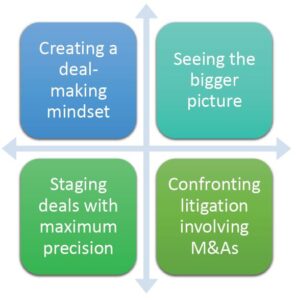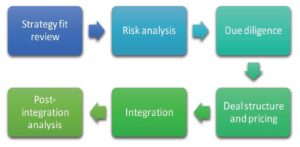Global M&As reached an all-time high in 2015, surpassing the previous record set in 2007. The $4.28 trillion worth of deals exceeded those of 2014 by more than $1 trillion. Today, companies are looking beyond industry boundaries and country borders for external growth opportunities. M&A decisions are among the most important that a board has to make and for many board members the M&A process is one of the most challenging, frustrating and dangerous.
While M&A activity is cyclical, deals themselves have become increasingly complex and sophisticated. In a fast-moving situation, directors are supposed to make all the most important decisions in a very short period of time. The complexity and urgency pose directors a significant challenge in terms of abilities and dedication of time and effort. Personal interests are also at stake; directors from both the acquiring and the target companies are at risk of losing their seats on the board. Decisions to approve or reject offers are closely watched and judged by investors, public authorities and other stakeholders. On the purchasing side of the deal, the directors of the acquiring company have to deal with criticism for paying too much, leaving money on the table, empire building, or of their huge egos. Pressure from employees, suppliers, customers, and regulators mounts, since they could all be affected by the outcome. The M&A process is a stress test for boards ‒ if anything goes wrong, damages can be claimed against the directors for breaches of duty or other alleged transgressions relating to the deals. Even if legal liability is not such an issue, reputational stakes are high. Directors are particularly vulnerable when overseeing M&A deals.
Given the high-stake role that directors play, M&A deals have to be well conceived, planned, structured and implemented. Failure to exercise appropriate oversight and succumbing to deal mania will only make the process stressful. In this article, we seek to create an M&A oversight framework for board members that will help them to make better M&A decisions.

Creating a deal-making mindset
M&A deals often start with a phone call. Shell’s CEO Ben Van Beurden explained how the deal with BG Group arose in April 2015, “I called Andrew (Gould) up and we had a very good and constructive discussion about the idea and it very quickly seemed to make sense to both of us.” In under a month, the two companies had put together a $50 billion oil megamerger.
The phone call may appear to be a sudden event with too much information and urgency. However, experienced directors probably wouldn’t see it like that – they conceive deals all the time, and are even prepared to sell the business the next day if the price is right. A board with a deal-making mindset has no problem showing how the deal will fit in with the company’s strategy.
A passive or reactionary approach to M&As is not the right solution for an active board. Boards with a strong M&A DNA have institutionalized M&A process, possibly through an M&A committee. The task of the committee is to supervise the company’s M&A strategy, challenge the thinking of executives on potential transactions, and analyze potential mergers, acquisitions, investments, or the disposition of any business. The board is constantly prepared for transactions and always has current knowledge on how to create value with specific deals.
Stakeholders, including shareholders, are motivated – anybody can propose a deal that might be beneficial. A dry run is typically organized (where investment bankers present a proposal), the deal flow is structured and analyzed (looking at the type of acquisition or the type of buyer that the organization can target, possibly mapping them into a matrix), and simulated discussions are encouraged.
The less informed consensus among the board’s directors on deals usually reveals a lack of preparation. Acquisitions are complex and should be challenged by specialist board members. As Andrew Gould, former chairman of BG Group, put it, “Boards must have the diversity of knowledge necessary to grasp the full implications of management’s recommendations and to remain independent judges of them. I am a firm believer that all boards should have their own body of industry specialists amongst the other skills that boards require.”
Typically, contrary opinions can help a board to make a better deal. This requires the appropriate means and structures to collect adequate information. For example, the board’s groundwork might uncover regulatory risk as a potential pitfall. Syngenta negotiated a break-up fee in case of regulatory problems with both of its potential buyers, Monsanto and ChemChina, which enhanced the overall value of the deal. The board needs to ensure that the work is structured, and that there is a good deal of information and specialization, as well as constructive dissent.
Seeing the bigger picture
Executives and deal advisors are often so focused on the deal itself that they become obsessed with it and lose sight of the big picture. An active board should be willing to prompt a deeper investigation of the assumptions to reassess all the challenges, risks and opportunities. From a board perspective, the full M&A process should include: 1. strategy fit review, 2. risk analysis, 3. due diligence, 4. deal structuring and pricing, 5. integration, and 6. post-integration analysis. The board should ensure that the full process is overseen in an objective way.
The big picture could be a corporate strategic shift, conducting a stream of similar transactions to support one strategy. Deals driven by a bigger strategy often succeed. China’s largest business property developer, Dalian Wanda Commercial Properties, a $40 billion company, has signaled a major shift in strategy in recent years. As a developer, Dalian Wanda clearly knew that China’s real estate market was probably facing an uncertain future and decided to reduce its reliance on property sales and make forays into “alternative, income-generating businesses away from the property market.” In pursuing this strategy, Dalian Wanda became an aggressive acquirer: In 2012 it acquired the US cinema chain AMC Theatres; in 2013 it purchased British yacht maker Sunseeker International; in 2015 it acquired Infront Sports & Media and the World Triathlon Corporation; and in 2016, Legendary Entertainment for $3.5 billion. From a strategic shift perspective, the company successfully expanded overseas to move away from China’s property market.
The big picture could also relate to the geographic, macro, economic, governance, technological, regulatory or societal environment. For example, what are the major differences in M&A practices from one country to another? Why are M&As at a record level? Is M&A activity related to interest rates? Why are investors becoming actively involved in pushing companies to sell businesses? Why is it good for a company to be owned by somebody else? In spite of the complexity of integration, why is it faster and more economical to acquire a company than to achieve internal growth? What are the regulatory barriers to deals? What are the tax implications of a potential deal? Synergies can be achieved through tax reduction and lower financing costs, as well as by streamlining inefficiencies in the combined functions of production, IT, supply chain, marketing, customer services and other operating areas. Syngenta chairman Michel Demaré estimated that a $2 billion synergy would cost 20,000 jobs. In the wider ecosystem, is synergy a synonym for externalizing costs? Is it in fact a zero sum game in the big picture?
Staging deals with maximum precision
In every stage of the transaction, the board’s comprehensive oversight can help management to follow a disciplined process. In this section, we discuss the board’s oversight role during the full M&A process.

1) Strategy fit review
The board needs to understand clearly why the deal is being made and should ask questions such as: How was the deal sourced? What are the potential and unique benefits? Is it intended to strengthen the core business, to acquire a technology, to establish market presence or to gain market share from the competition? What are the basic assumptions driving the deal? Are the assumptions about synergies realistic? Synergies are typically highly overvalued by executives and advisors alike. What is the plan to achieve synergies? Who would be negatively impacted in the process of materializing synergies? What other benefits are expected? Does the culture of the target align with that of the acquirer? How does this deal advance the company’s long-term strategy? With a large percentage of M&A deals destroying value, how will this particular deal be different?
It is also a board’s responsibility to be independent and create an open discussion environment, encourage debate, and keep dominant individuals in check. In this way, everyone can contribute openly to the strategic fit analysis. This is particular relevant when a CEO is determined to go through with the deal and threatens to resign if it is not approved. The question is, why is the CEO so keen to transact M&A deals? How well prepared is the board to face the threat of resignation? Would the board be able to carry out an independent strategic fit review?
2) Risk analysis
No matter how diligently the board works, there are always information gaps between what it needs to make the best decisions and what it can obtain. There is no doubt that acquisitions can offer growth opportunities, but they are by nature complex and risky. When considering an M&A strategy, opportunity is often accompanied by risk and uncertainty.
Typical risks include human dynamics. Andrew Gould remarked, “My observation from both near and far is that human failing is by far the most critical element in badly judged large M&A transactions. The ability to retain the power of the CEO role and the degree of intellectual humility necessary to execute it properly is not given to many people. Hubris is an occupational hazard for leaders, it feeds on isolation, and business leaders can deceive themselves and distance themselves from reality…It is important to point out that the hubris syndrome can be acquired during the exercise of power and may disappear once the individual has left the positon of influence.” Typically, in the leadership team, ego and office politics obstruct objective debate; advisors make deals for a fee and are not accountable for the results; or leadership differences exist between the acquirer and the target. Human dynamics can lead to other risks, such as a flawed strategic rationale, pricing discrepancies, financing flaws and post-acquisition execution.
In 2016, regulatory barriers are considered the biggest threat for global M&As, according to a survey. A record number of deals were blocked or abandoned as a result of anti-trust hurdles, including Comcast’s $45 billion offer for Time Warner Cable after regulators raised concerns that the deal would create a monopoly. The rise of anti-trust interference is a global phenomenon and 71% of executives blame competition regulators for their failed deals. Top regulatory concerns vary according to sector. In the energy, mining and natural resources sector, for example, environmental regulations are of the most concern for companies contemplating deals, while in the telecommunications, media and technology sector, data protection and cyber security regulations are at the top of the list, according to the survey.
In general, integration failure is the top concern for boards, since capturing synergy is one of the biggest risks. To make integration work, boards have to communicate constantly with stakeholders, stabilize the morale of both companies, supervise the integration of structures and processes, and approve specific initiatives to achieve the strategic objectives. Some boards shed the responsibility of decision-making and let the problems fix themselves, for example the concept of co-CEOs, co-chairmen, or having two headquarters. This practice usually does not work in the long term, since the two companies still work separately rather than as one unified entity.
3) Due diligence
Due diligence is a critical process to validate accounting information and the acquisition rationale to obtain a true understanding of the target company and how the acquisition might advance the intended strategy. For larger transactions, the management should present a report to the board describing the scope, timeline and resources for each due diligence phase and the results.
According to a Deloitte study, a thorough due diligence process can include:
- Commercial and operational diligence
- Legal diligence
- Financial and accounting diligence
- Tax diligence
- Employee benefit and human resources due diligence
- Foreign Corrupt Practices Act due diligence
- Reputational due diligence
- Integration and synergy due diligence
- Insurance due diligence
- Environmental due diligence
- Engineering due diligence
Boards should engage in oversight of the entire due diligence process. As the list shows, due diligence should focus not only on financial risk but also on non-financial matters – the technological, operational and reputational dimensions of the deal. In terms of tangibles, boards need to devote sufficient time to issues related to intellectual property and technology before these issues begin to cause problems. In terms of intangibles – non-financial due diligence – boards need to consider cultural compatibility, stakeholder reactions and employee morale. What if the specialized employees and talents do not believe in the deal? How can all the intangibles be managed? The board must undertake a thorough, well-documented investigation before acting.
4) Deal structure and pricing
Boards should be especially vigilant when it comes to evaluating the financial aspects of a deal. Is it worthwhile? Are we paying the right price? Who is pricing the deal – the bankers or an internal team? Is the financing reasonable? What is the impact of potential holdbacks and escrows? How is a cash plus share offer different from an all-cash deal? Why is an acquisition better than the alternatives (joint venture, organic growth, alliance or partnership)?
Companies must have strong in-house valuation skills; if they put themselves in the hands of others, they will probably run the risk of overpaying. Vodafone’s $183 billion takeover of Mannesmann in 2000 marked the biggest cross-border bid in history. In total, Vodafone paid 56 times earnings, a 72% premium to Mannesmann’s closing share price. Five years later, Vodafone announced it would take a goodwill charge of $40 billion. The company admitted that, embarrassingly, the record post-acquisition write-downs were due to overpayment. This deal destroyed significant value, largely because the flawed valuation was performed by outsiders. Boards should be aware that regardless of the sophisticated financial models used in pricing, valuation is relative. Value is measured in the eye of the beholder. What provides value to one specific acquirer or target might not provide the same value for others. Pricing is a key dimension of the sales or purchase decision. Overpricing often leads to the failure of the acquirer.
In 2016 Syngenta’s board voted unanimously to accept the $43 billion all-cash offer from ChemChina. For a few years, Monsanto had been courting Syngenta as a takeover but Syngenta had rejected all previous offers, including a $46.6 billion cash plus share proposal in 2015. Speaking with a newspaper reporter, Michel Demaré hinted that strategy fit, deal structure and the differences in company culture between Monsanto and Syngenta had ruined the chances of a deal between them. While Monsanto’s offer set a benchmark for the value of the company, pricing may have been a secondary consideration for ChemChina. The company’s investment in Syngenta was widely considered as a way of securing a food supply for China’s growing population and accessing Syngenta’s intellectual property and cropcare technology. Unlike Monsanto, ChemChina had no intention of dismantling, reintegrating and selling parts of Syngenta to extract synergies.
5) Integration
Before the deal is approved, directors need to carefully review the integration plan. What is the timeline? How fast can the company be integrated? What are the expected problems? Who will lead the integration? Will the same team be involved throughout the pre-deal, deal, and post-deal process? What are the major milestones? What technical problems, IT and others, can be expected? How can the two company cultures be aligned? Who are the key people from the acquired company to retain? How long should an acquirer retain the management of the target company? What are the key metrics for measuring integration success? The board should get regular updates on the progress of the integration.
Companies often underestimate the timing and cost involved in completing an overseas integration. In some jurisdictions, there are significant employment entitlements that require complex consultation with the affected employees. These factors could become obstacles to successful integration. Ideally, therefore, those deemed responsible for the integration process should already have been involved in the pre-deal negotiations.
6) Post-integration analysis
Finally, the board should review the integration process after the acquisition and ask: How successful was it? Have we achieved the strategic goals? Have we focused on the right issues? What have we learned in the process to help make the next deal more successful? Have we established a process for evaluating the success of deals? Ideally, such a step should be planned at an early stage of the deal negotiation.
Confronting litigation involving M&As
In the M&A process, boards should recognize that directors are vulnerable to litigation in many legal environments and not only in the US. A research report released in 2015 revealed that investors there contested 93% of M&A transactions in 2014. Failure to do the necessary homework, as well as to obtain adequate insurance coverage, could result in significant damage to the deal and the company. In this section, we discuss how litigation typically arises when boards fail to handle deals properly.
1) Conflicts of interest
Conflicts of interest continue to dominate the discussions in M&A litigation. Typical conflicts of interest include large shareholder involvement in the deal, management negotiating employment and compensation packages during the deal, and advisors dealing on all sides. Boards that fail in their oversight could be sued for breaching their duty of care.
In 2011 Barclays Capital and Del Monte Corp. agreed to pay the food company’s shareholders to settle a case that raised a conflict of interest. The Delaware Court of Chancery found that the advisor, Barclays, helped with the buy-side financing and failed to disclose its relationship with the target. Del Monte’s board failed to provide the oversight that would have checked Barclay’s misconduct. Del Monte paid $65.7 million of the settlement, while Barclays Capital paid the remaining $23.7 million, according to the court filings.
2) Lack of disclosure
Class action lawsuits are often filed alleging that boards have failed in disclosure. Disclosure might include the existence of the M&A negotiations, deal terms or other material information about the transaction. These suits can potentially cause significant damage to the companies involved in both sides of M&A deals.
This could cause a dilemma for the boards of target companies – premature disclosure can be damaging to shareholders; if the disclosure is too late, shareholders could allege that they were injured since they sold their shares just before the large price increase following the merger announcement. A lawsuit can also be brought against the acquiring company because the M&A negotiations or the future prospects and effect on the acquiring company have not been fully disclosed by the board in a timely manner.
3) Hostile and friendly takeovers
The directors of a target company who resist a hostile takeover could be sued. Shareholders could allege that the directors are breaching their fiduciary duty and denying the shareholders the opportunity to profit from the high offer price.
Likewise, the directors of a target company who approve a friendly takeover could also be sued. Disgruntled shareholders could allege that the company is being sold for too little and the directors have failed to make a good decision.
4) Mismanagement
After a company has been acquired, the previous directors and executives of the target company could be sued by the new company. They could claim that the directors of the acquired company mismanaged the company prior to the acquisition, which could be problematic for the former directors since they no longer control the company and if they have no insurance coverage. The board and directors of the acquiring company could be sued after the acquisition if, for example, the new management team has little experience in the industry or markets of the target company.
Conclusion
How can the board and directors add value to the M&A process and reduce the risk? This article aims to help boards and directors to rethink their M&A oversight framework and identify questions or issues when overseeing potential deals. The main principles are simple:
- Creating a deal-making mindset
- Seeing the bigger picture
- Staging deals with maximum precision
- Confronting litigation involving M&As.
Boards and directors are crucial in helping their companies to capture value during the M&A process and reduce the risk of failure. We encourage every board and director to consider these principles and prepare for the challenges – seeing the big picture, making some of their most important decisions and confronting the corporate reality of risk, uncertainty and potential litigation.











